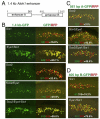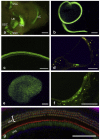The regulation of gene expression in hair cells
- PMID: 25616095
- PMCID: PMC4510037
- DOI: 10.1016/j.heares.2014.12.013
The regulation of gene expression in hair cells
Abstract
No genes have been discovered for which expression is limited only to inner ear hair cells. This is hardly surprising, since the number of mammalian genes is estimated to be 20-25,000, and each gene typically performs many tasks in various locations. Many genes are expressed in inner ear sensory cells and not in other cells of the labyrinth. However, these genes are also expressed in other locations, often in other sensory or neuronal cell types. How gene transcription is directed specifically to hair cells is unclear. Key transcription factors that act during development can specify cell phenotypes, and the hair cell is no exception. The transcription factor ATOH1 is well known for its ability to transform nonsensory cells of the developing inner ear into hair cells. And yet, ATOH1 also specifies different sensory cells at other locations, neuronal phenotypes in the brain, and epithelial cells in the gut. How it specifies hair cells in the inner ear, but alternate cell types in other locations, is not known. Studies of regulatory DNA and transcription factors are revealing mechanisms that direct gene expression to hair cells, and that determine the hair cell identity. The purpose of this review is to summarize what is known about such gene regulation in this key auditory and vestibular cell type.
Published by Elsevier B.V.
Figures





Similar articles
-
The Promoter and Multiple Enhancers of the pou4f3 Gene Regulate Expression in Inner Ear Hair Cells.Mol Neurobiol. 2017 Sep;54(7):5414-5426. doi: 10.1007/s12035-016-0060-7. Epub 2016 Sep 3. Mol Neurobiol. 2017. PMID: 27592349 Free PMC article.
-
Atoh1 and other related key regulators in the development of auditory sensory epithelium in the mammalian inner ear: function and interplay.Dev Biol. 2019 Feb 15;446(2):133-141. doi: 10.1016/j.ydbio.2018.12.025. Epub 2018 Dec 31. Dev Biol. 2019. PMID: 30605626 Review.
-
Barhl1 regulatory sequences required for cell-specific gene expression and autoregulation in the inner ear and central nervous system.Mol Cell Biol. 2008 Mar;28(6):1905-14. doi: 10.1128/MCB.01454-07. Epub 2008 Jan 22. Mol Cell Biol. 2008. PMID: 18212062 Free PMC article.
-
Regulation of POU4F3 gene expression in hair cells by 5' DNA in mice.Neuroscience. 2011 Dec 1;197:48-64. doi: 10.1016/j.neuroscience.2011.09.033. Epub 2011 Sep 19. Neuroscience. 2011. PMID: 21958861 Free PMC article.
-
Atoh1 in sensory hair cell development: constraints and cofactors.Semin Cell Dev Biol. 2017 May;65:60-68. doi: 10.1016/j.semcdb.2016.10.003. Epub 2016 Oct 14. Semin Cell Dev Biol. 2017. PMID: 27751776 Review.
Cited by
-
Generation of inner ear hair cells by direct lineage conversion of primary somatic cells.Elife. 2020 Jun 30;9:e55249. doi: 10.7554/eLife.55249. Elife. 2020. PMID: 32602462 Free PMC article.
-
Preservation of Cells of the Organ of Corti and Innervating Dendritic Processes Following Cochlear Implantation in the Human: An Immunohistochemical Study.Otol Neurotol. 2018 Mar;39(3):284-293. doi: 10.1097/MAO.0000000000001686. Otol Neurotol. 2018. PMID: 29342037 Free PMC article.
-
The Promoter and Multiple Enhancers of the pou4f3 Gene Regulate Expression in Inner Ear Hair Cells.Mol Neurobiol. 2017 Sep;54(7):5414-5426. doi: 10.1007/s12035-016-0060-7. Epub 2016 Sep 3. Mol Neurobiol. 2017. PMID: 27592349 Free PMC article.
-
Hearing loss genes reveal patterns of adaptive evolution at the coding and non-coding levels in mammals.BMC Biol. 2021 Nov 16;19(1):244. doi: 10.1186/s12915-021-01170-6. BMC Biol. 2021. PMID: 34784928 Free PMC article.
-
Focal Degeneration of Vestibular Neuroepithelium in the Cristae Ampullares of Three Human Subjects.Otol Neurotol. 2018 Dec;39(10):e1100-e1110. doi: 10.1097/MAO.0000000000002018. Otol Neurotol. 2018. PMID: 30303940 Free PMC article.
References
-
- Babu MM, Luscombe NM, Aravind L, Gerstein M, Teichmann SA. Structure and evolution of transcriptional regulatory networks. Curr. Opin. Struct. Biol. 2004;14:283–291. - PubMed
-
- Ben-Tabou de-Leon S, Davidson EH. Gene regulation: gene control network in development. Annu Rev. Biophys. Biomol. Struct. 2007;36:191. - PubMed
-
- Bermingham NA, Hassan BA, Price SD, Vollrath MA, Ben-Arie N, Eatock RA, Bellen HJ, Lysakowski A, Zoghbi HY. Math1: an essential gene for the generation of inner ear hair cells. Science. 1999;284:1837–1841. - PubMed
-
- Boëda B, Weil D, Petit C. A specific promoter of the sensory cells of the inner ear defined by transgenesis. Hum. Mol. Genet. 2001;10:1581–1589. - PubMed
Publication types
MeSH terms
Substances
Grants and funding
LinkOut - more resources
Full Text Sources
Other Literature Sources

